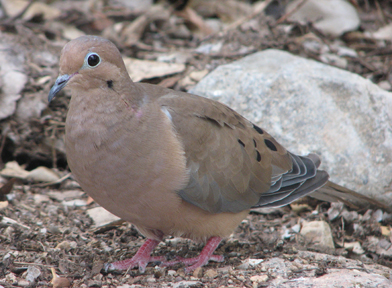|
This photograph of a mourning dove was taken at the Arizona-Sonora Desert Museum. Desert Duets: Mourning Dove Info Web Page Information about Mourning Doves "ooAAH-cooo-coo-coo. ooAAH-cooo-coo-coo. ooAAH-cooo-coo-co." Listen to the mourning dove's call on the Cornell Lab of Ornithology Web page. Is this the saddest bird song? The word "mourning" means grieving, and that's how this dove got its name. Although it may sound sad, scientists say the mourning dove's song is used for marking its territory and for mating. Some people think of mourning doves as the pigeons of the Sonoran Desert. Actually, mourning doves are part of the pigeon family and live throughout North America. Whether you live in the Sonoran Desert in a city or in the country, mourning doves are one of the most common birds you will see and hear. The mourning dove is between 11 and 13 inches long with a wingspan of 17 to 19 inches. Its body is long and pointed, which helps it fly up to 55 mph! The mourning dove has a small black spot on its face. Experts can see the differences in the feathers of male and female mourning doves. The male has a bluish crown on its head and bluish feathers on the nape of the neck. The male also has a pinkish cast on its throat and breast. Studies have shown that mourning doves mate for life. Mourning doves scratch on the ground
for their food. As you can see in the photograph above, they camouflage
well with the rocky ground. They eat mostly seeds,
but occasionally eat insects. Their strong legs and feet help them launch
quickly from the ground if a predator threatens them. When they lift
off, their wings make a whistling sound. Even though they are quick,
strong flyers, hawks,
falcons, and humans hunt, kill, and eat mourning
doves. Mourning Dove Pages:
Home | Information
| Babies | Activity
| Resources |
